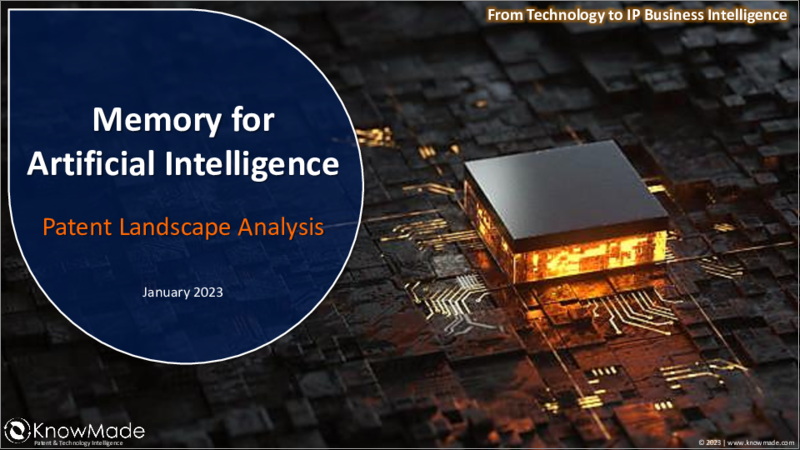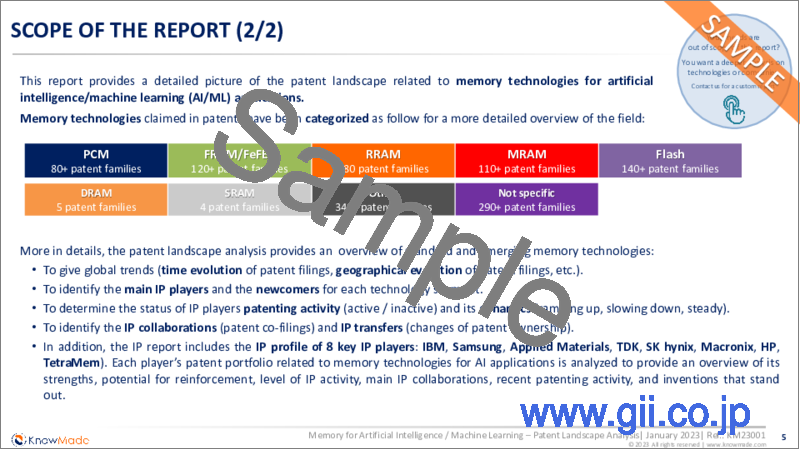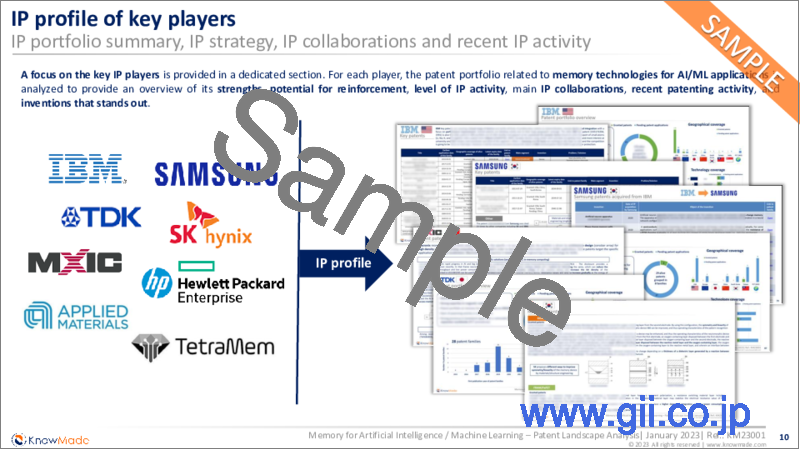|
|
市場調査レポート
商品コード
1192495
人工知能 (AI) 用メモリの特許情勢の分析 (2023年)Memory for Artificial Intelligence Patent Landscape Analysis 2023 |
||||||
| 人工知能 (AI) 用メモリの特許情勢の分析 (2023年) |
|
出版日: 2023年01月23日
発行: KnowMade
ページ情報: 英文 PDF >100 slides, Excel file >1,300 patent families
納期: 即日から翌営業日
|
- 全表示
- 概要
- 目次
当レポートでは、人工知能 (AI) 向けメモリに関する特許の最新情勢について分析し、人工知能/機械学習 (AI/ML) 用途に適したメモリ技術の概略や、昨今の特許出願・承認の動向、セグメント別の詳細動向、主要IP企業 (特許所有者/出願人) のプロファイルと特許ポートフォリオ、といった情報を取りまとめてお届けいたします。
分析の主な特徴
- 100枚以上のスライドを含むPDF
- 当レポートで分析した全ての特許 (1,300以上の特許ファミリー) を含むExcelデータベース (特許区分と更新されたオンラインデータベースへのハイパーリンクを含む)
- 世界の特許動向:特許公開の時間的推移、特許の出願国など
- 各セグメントにおける、主な特許譲受企業や新規参入企業の特定
- 特許活動の状況 (活発/不活発) とIP動向 (活発化、減速、安定化) の把握
- IP連携 (特許共同出願) およびIPトランスファー (特許所有権の変更) の特定します
- ニューロモルフィック計算のために開発された技術に基づく、特許の分類 (計9分野):ReRAM、PCM、MRAM、FRAM/FeFET、Flash、DRAM、SRAM、その他
- 主要IP企業8社のIPプロファイル:特許ポートフォリオの概要 (IPの動向、分類、法的地位、地理的範囲など)、IP連携、主要特許、最近の特許出願活動
分析の背景事情
ニューロモーフィック計算は近年、ムーアの法則以降の時代における有望な技術として浮上しています。ニューロモーフィック計算システムは、高度な接続性と並列性を持ち、消費電力やメモリ内の処理量が比較的少ないのが特徴です。このようなシステムをハードウェアで実現するためには、生物を模倣した人工ニューロンとシナプスが必要です。どちらも電力効率に優れ、スケーラブルで、大規模なニューロモルフィック機能を促進するための関連学習ルールを実装できるものでなければならないです。このため、MRAMやPCM、ReRAM (メモリスター)、CB-RAM、FeRAM、FeFET、シナプストランジスタなどの新しいメモリーを使って人工ニューロンおよびシナプスを作る試みがここ数年間数多く行われています。
そこで、Knowmadeは、人工知能/機械学習 (AI/ML) アプリケーション向けのメモリ技術に関連する特許状況を、材料やデバイスからそれらを使用するシステムや方法まで、メモリ技術 (ReRAM、PCM、MRAM、FRAM/FeFET、フラッシュ、DRAM、SRAMなど) に分類して包括的に把握することを目的に、新しいレポートを発表します。
当レポートでは、以下のような疑問に答えることを目的としています。
- 人工知能/機械学習 (AI/ML) に、他より適した特定のメモリ技術はあるか?
- この分野の主な特許所有者と特許出願人は誰か?
- 特許の対象となる技術課題は何か?また、保護対象は何か? (デバイス、システム、方法など)
- 人工知能/機械学習 (AI/ML) に特化して開発されたメモリには、どのような特性があるのか?
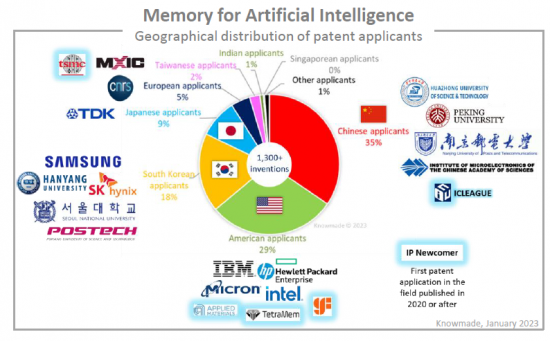
特許の分類
特許は、ニューロモルフィック計算のために開発されたメモリ技術によって、抵抗ベースの新興メモリ技術 (ReRAM、PCM、MRAM)、偏光ベースの新興メモリ技術 (FRAM/FeFET)、従来のメモリ技術 (フラッシュ、DRAM、SRAM)、その他のメモリ技術 (シナプティックイオントランジスタ、2Dまたは1D材料に基づくデバイス、ハイブリッド材料、ペロブスカイト、ナノ粒子、量子物理、有機材料、スキルミオンなど)、特定しない (メモリ技術の種類が特定されていない) などに分類されています。
すべての新興メモリが現在調査中であり、近年はFRAMの保護が増加傾向にあります。RRAMは、世界で最も発明が多く、実施可能な特許の数も多い技術です。
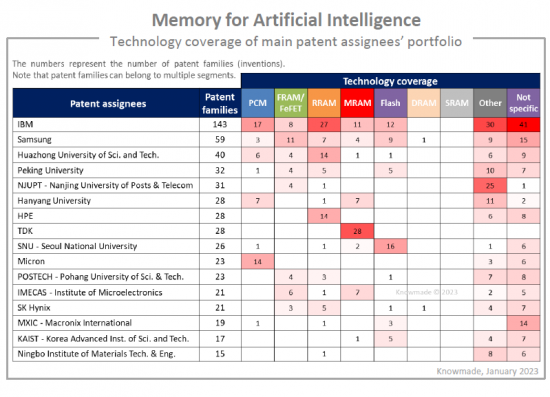
IPプロファイル:大手IP企業の特許ポートフォリオに注目
IPレポートには、主要IP企業8社のIPプロファイルが含まれています:IBM、Samsung、Applied Materials、TDK、SK hynix、Macronix、HP、TetraMem。
各企業のAI用メモリ技術に関する特許ポートフォリオを分析し、その強み、強化の可能性、IP活動のレベル、主なIP連携、最近の特許活動、主要な発明などの情報を提供しています。
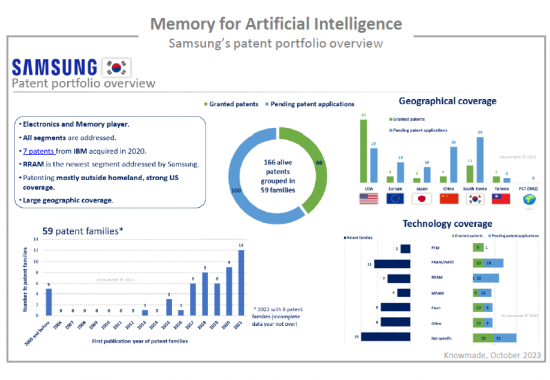
Excel特許データベース
当レポートには、分析対象の1,300以上のパテントファミリー (発明) を収録した広範なエクセルデータベースが含まれています。この有用な特許データベースは、多基準検索が可能で、特許公開番号、最新のオンラインデータベースへのハイパーリンク (原文、法的状況など)、優先日、タイトル、要約、特許譲渡人、特許の現在の法的状況、9セグメント (RRAM、PCM、MRAM、FeRAM/FeFET、フラッシュ、DRAM、SRAM、その他、特定せず) などを収録しています。
当レポートに記載された企業 (一部)
- 産業界: IBM、Samsung、HP、TDK、Micron、SK Hynix、Macronix、Intel、TetraMem、GlobalFoundries、Fujitsu、Thales、Panasonic、Sony、Toshiba/Kioxia、Applied Materials、Winbond Electronics、Honeywell、Monolithic 3D、Qualcomm、TSMC、Gyrfalcon、I & F、ICLeague、Merck、NTT、Olympus、Rohm、HRL Labs、Semron、Synopsys、Texas Instruments、Western Digital、Crossbar、Weeebit、Nanteroなど。
- 研究機関: Research organizations: Huazhong University of Science and Technology、Peking University、Nanjing University of Posts & Telecommunications (NJUPT)、Hanyang University、Seoul National University (SNU)、Pohang University of Science and Technology (POSTECH)、Institute of Microelectronics、Chinese Academy of Sciences (IMECAS)、Korea Advanced Institute of Science and Technology、Ningbo Institute of Materials Technology & Engineering (NIMTE)、Tsinghua University、CNRS - French National Research Center、Fudan University、Nanjing University、University of Electronic Science and Technology of China (UESTC)、Hebei University、Beihang University、Fuzhou University、University of Nankai (NKU)、Shandong University of Science and Technology、Sungkyunkwan University、Kookmin University、California Institute of Technology (Caltech)、Harvard University、CEA - French Alternative Energies and Atomic Energy Commissionなど。
目次
イントロダクション
エグゼクティブサマリー
特許情勢の概要
- 特許公開のタイムライン
- IP企業の所在地
- 産業用IP企業の所在地
- 主な特許出願人のランキング
- 特許の現在の法的地位
- インダストリアルに注目
- 産業特許譲受人の類型
- 企業が保有する特許:現在の法的地位
- 産業用IP企業のタイムライン
- 産業界が保有する存続中の特許の地理的範囲
- 産業特許譲受人のIPリーダーシップ
- 産業特許譲受人の主なIP連携
- Samsung/IBMのIP連携
- SK HynixのIP連携
- 事業会社:概要
- 研究機関に注目
- 研究機関の所在地
- 研究機関の特許譲受人のIPリーダーシップ
- アカデミックIPプレーヤーのタイムライン
- 研究機関の主なIP連携
- 研究機関が保有する有効特許の地理的分布
- 研究機関:概要
特許の分類
- AI/ML向けのメモリ技術
- 特許の分類
- 各メモリ技術の特許公開の時間的変化
- AI/ML向けメモリ技術の主な特許出願人
- その他のメモリ技術
- 新規NVM (不揮発メモリ) の特許譲受人のIPリーダーシップ
- 主な特許ファミリー
- 分析手法
- 主要特許の選定
- その他の注目すべき特許ファミリー
主要企業のIPプロファイル
- IBM
- Samsung
- Applied Materials
- TDK
- SK Hynix
- Macronix International
- Hewlett Packard
- TetraMem
- RRAMのコアビジネスを持つ企業:メモリ関連の特許でAI/ML用途について明確に言及されていないため、当レポートでは省略
結論
付録
Knowmadeのプレゼンテーション
Are there specific memory technologies claimed in patents that are more suitable than others for artificial intelligence/machine learning (AI/ML) applications? Who are the key patent owners and the most active patent applicants in the field?
Report's Key Features:
- PDF>100 slides
- Excel database containing all patents analyzed in the report (>1,300 patent families), including patent segmentations and hyperlinks to an updated online database.
- Describing the global patenting trends, including time evolution of patent publications, countries of patent filings, etc.
- Identifying the main patent assignees and the IP newcomers in the different segments.
- Determining the status of their patenting activity (active / inactive) and their IP dynamics (ramping up, slowing down, steady).
- Identifying the IP collaborations (patent co-filings) and IP transfers (changes of patent ownership).
- Patents categorized into 9 segments according to technologies developed for neuromorphic computation: ReRAM, PCM, MRAM, FRAM/FeFET, Flash, DRAM, SRAM, etc.
- IP profile of 8 key IP players: patent portfolio overview (IP dynamics, segmentation, legal status, geographic coverage, etc.), IP collaborations, key patents, and recent patenting activity.
Report context:
In recent years, neuromorphic computing has emerged as a promising technology in the post-Moore's law era. Neuromorphic computing systems are highly connected and parallel and consume relatively low power and processes in memory. Artificial neurons and synapses that mimic biological ones are needed to implement such a system on hardware. Both must be power-efficient, scalable, and capable of implementing relevant learning rules to facilitate large-scale neuromorphic functions. To this end, numerous efforts have been made over the last few years to create artificial neurons and synapses using emerging memories, including magnetoresistive random-access memory (MRAM), phase-change memory (PCM), resistive random-access memory (ReRAM or memristors), conductive bridging random-access memory (CB-RAM), ferroelectric random-access memory (FeRAM), ferroelectric field-effect transistor (FeFET), synaptic transistors, and others.
In this context, Knowmade is releasing a new report that aims to provide a comprehensive view of the patent landscape related to memory technologies for artificial intelligence/machine learning (AI/ML) applications, from materials and devices to the systems and methods that use them, categorized into memory technologies (ReRAM, PCM, MRAM, FRAM/FeFET, Flash, DRAM, SRAM, etc.).
In this report, we aim to answer the following questions:
- Is there a specific memory technology more suitable than others for artificial intelligence/machine learning (AI/ML)?
- Who are the main patent owners and patent applicants in the field?
- What are the technical challenges targeted in patents, and what is protected (device, system, method, etc.)?
- Are there memory properties developed more specifically for intelligence/machine learning (AI/ML)?

Patent landscape analysis is a powerful tool for understanding the competitive and technological environment. It makes it possible to identify new players in emerging industries long before they enter the market while providing a better understanding of their expertise and know-how of a specific technology. Overall, patenting activity (patent filings) reflects the level of R&D investment made by a country or player in a specific technology while providing clues as to the technology readiness level reached by the main IP players. What's more, the technology coverage and the geographical coverage of the patent portfolios are closely related to the business strategy of IP players.
A diversified ecosystem of semiconductor companies
A mix of IC and memory players, universities, and R&D centers are competing for innovation at all stages of the R&D ladder. Industrial companies' patenting activity took off in 2015 after R&D efforts were focused on research and fundamental physics knowledge. American and Korean industrials and Chinese and Korean universities mainly hold patents. Top patent assignees are well-established semiconductor companies, and IBM and Samsung have a leading IP position. New players such as Applied Materials, TSMC, GlobalFoundries, TetraMem, and ICLeague are entering the game, and their intellectual property (IP) may become important in the coming years.
Patent segmentation
The patents have been categorized according to the memory technologies developed for neuromorphic computation: resistance-based emerging memory technology (ReRAM, PCM, MRAM), polarization-based emerging memory technology (FRAM/FeFET), traditional memory technologies (Flash, DRAM, SRAM), other memory technologies (synaptic ionic transistor, devices based on 2D or 1D materials, hybrid materials, perovskites, nanoparticles, quantum physics, organic materials, skyrmions, etc.), and not specific (type of memory technology not specified).
All emerging memories are currently under investigation, with an upward trend for protecting FRAM in recent years. RRAM is the technology with the most inventions and the most significant number of enforceable patents worldwide.

IP profiles: focus on the top IP players' patent portfolios
The IP report includes the IP profile of eight key IP players: IBM, Samsung, Applied Materials, TDK, SK hynix, Macronix, HP, and TetraMem.
Each player's patent portfolio related to memory technologies for AI applications is analyzed to provide an overview of its strengths, potential for reinforcement, level of IP activity, main IP collaborations, recent patenting activity, and inventions that stand out.

Useful Excel patent database
This report includes an extensive Excel database with the 1,300+ patent families (inventions) analyzed in this study. This useful patent database allows for multicriteria searches and includes patent publication numbers, hyperlinks to an updated online database (original documents, legal status, etc.), priority date, title, abstract, patent assignees, patent's current legal status, and nine segments (RRAM, PCM, MRAM, FeRAM/FeFET, Flash, DRAM, SRAM, other, not specific).
Companies mentioned in the report (non-exhaustive)
- Industrials: IBM, Samsung, HP, TDK, Micron, SK Hynix, Macronix, Intel, TetraMem, GlobalFoundries, Fujitsu, Thales, Panasonic, Sony, Toshiba/Kioxia, Applied Materials, Winbond Electronics, Honeywell, Monolithic 3D, Qualcomm, TSMC, Gyrfalcon, I & F, ICLeague, Merck, NTT, Olympus, Rohm, HRL Labs, Semron, Synopsys, Texas Instruments, Western Digital, Crossbar, Weeebit, Nantero, etc.
- Research organizations: Huazhong University of Science and Technology, Peking University, Nanjing University of Posts & Telecommunications (NJUPT), Hanyang University, Seoul National University (SNU), Pohang University of Science and Technology (POSTECH), Institute of Microelectronics, Chinese Academy of Sciences (IMECAS), Korea Advanced Institute of Science and Technology, Ningbo Institute of Materials Technology & Engineering (NIMTE), Tsinghua University, CNRS - French National Research Center, Fudan University, Nanjing University, University of Electronic Science and Technology of China (UESTC), Hebei University, Beihang University, Fuzhou University, University of Nankai (NKU), Shandong University of Science and Technology, Sungkyunkwan University, Kookmin University, California Institute of Technology (Caltech), Harvard University, CEA - French Alternative Energies and Atomic Energy Commission, etc.
TABLE OF CONTENTS
INTRODUCTION
- Questions answered by the patent and scape
- Scope of the report
- Reading guide
- Main patent assignees mentioned in this report
EXECUTIVE SUMMARY
PATENT LANDSCAPE OVERVIEW
- Time evolution of patent publications
- IP players location
- Industrial IP players location
- Ranking of main patent assignees
- Current legal status of the patents
- Focus on industrials
- Typology of industrials patent assignees
- Current legal status of patents held by industrials
- Timeline of industrial IP players
- Geographical coverage of alive patents held by industrial players
- IP leadership of industrial patent assignees
- Main IP collaborations of industrial patent assignees
- Samsung / IBM IP collaboration
- SK Hynix IP collaborations
- Industrial companies: summary
- Focus on research organizations
- Research organization location
- IP leadership of research organization patent assignees
- Timeline of academic IP players
- Main IP collaborations of research organizations
- Geographical distribution of alive patents held by research organizations
- Research organizations: summary
PATENT SEGMENTATION
- Memory technologies for AI/ML
- Patent segmentation
- Time evolution of patent publications for each memory technology
- Main patent assignees by memory technologies for AI/ML
- Other memory technologies
- IP leadership of patent assignees for emerging NVM
- Key patent families
- Methodology
- Selection of key patents
- Other notable patent families
IP PROFILES OF KEY PLAYERS
- IBM
- Samsung
- Applied Materials
- TDK
- SK Hynix
- Macronix International
- Hewlett Packard
- TetraMem
- Companies with RRAM core business, but being absent of this report since none of their memory-related patents explicitly mention AI/ML application
CONCLUSION
ANNEX
- Methodology for patent search, selection and analysis
- Methodology to identify key patents and key IP players
- Terminology
